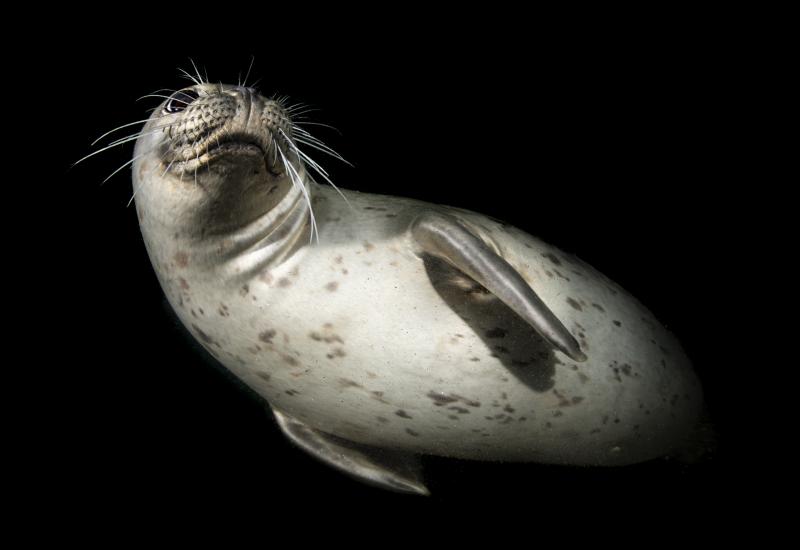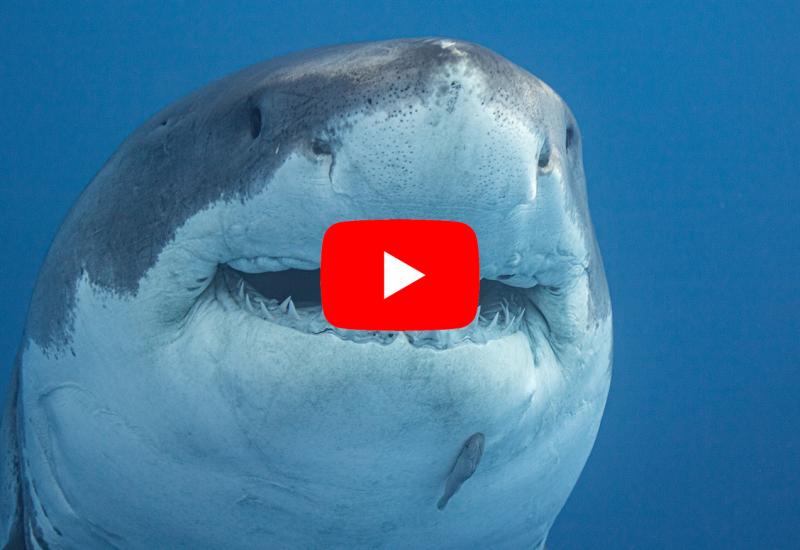How Low Can You Go?
The average surface temperature of the world's oceans is roughly 62°F/17°C, but most divers spend their entire diving career in water that is considerably warmer. If you have only visited tropical destinations, you might be missing out. With the right exposure protection, you can enjoy the Arctic as much as the Equatorial waters. How low will you go to experience some of the world's greatest dives?
Truk Lagoon, Federated States of Micronesia
Temperature range: 81-86°F/27-30°C
Average temperature: 28.8°C / 83.8°F

Jill HeinerthPam Wooten explores the Fujikawa Maru in Truk Lagoon.
Diving in the South Pacific feels like jumping into bathwater. Some locations, such as the Great Barrier Reef, are struggling with rising water temperatures. Still, Chuuk, Micronesia, the home of the historic WWII battle of Operation Hailstone, offers resplendent corals covering magnificent wrecks. The colorful sponges and soft corals are so thick that at times you will feel as though you are swimming along a reef rather than the rusty steel hull of a Japanese merchant vessel. A 3mm wetsuit is almost overkill, but it will protect you if you decide to follow a guide down the twisted corridors to reach an engine room.
Grand Cayman, B.W.I.
Temperature range: 87F/30C (August) to 78F/25C (January)
Average temperature: 80F/27C

Jill HeinerthRenee Power inspects a beautiful red rope sponge on the wall in Grand Cayman.
Even during winter, the Cayman Islands and much of the Caribbean, offer swimming-pool-like diving temperatures. Whether you want to interact with a fever of stingrays (yes, that is the collective noun for rays) or plunge deep down the colorful walls of Cayman Brac, you will rarely encounter a cold thermocline. You can pack a dive skin or a 3mm wetsuit to enjoy long swims in the transparent clarity and surface to the warmth of a sunny Caribbean afternoon.
Sharm el-Sheikh, Egypt
Red Sea
Temperature range: 79F/26C (July) to 69F/21C (February)
Average temperature: 73F/23C

Jill HeinerthThe shallow reefs in Sharm al Sheikh are respeldent with swarms of fish.
The WWII wreck SS Thistlegorm is ranked as one of the best dive sites in the world, both for its artifacts and marine life. You might get swarmed by barracuda, jacks, and snapper while you make your way down into the holds that carry locomotives, tanks, trucks, and motorbikes. As with any wreck, you need protection against cuts and abrasions, and if you dive in the wintertime, you'll probably want a 5 mm suit or at least layers that include a vest or hood. Strong currents in the area mean that the temperatures can vary wildly, so err on the safe side by bringing something that can protect you down to 61F or 16C.
Azores Islands, Portugal
Temperature range: 73F/23C (September) to 61F/16C (February)
Average temperature: 60F/16C

Jill HeinerthTwo mobula rays rise above a sea mount in Santa Maria Island, Azores.
One of the keystone dives of the Azores is the opportunity to swim with giant Mobula rays that congregate over a seamount near Santa Maria Island. Winter temperatures drop to 61F/16C, but you'll want to wear a 5mm with hood or vest. Fierce currents attract the rays to feed but are too strong for swimming, so divers hang onto a moored vertical line. You will be motionless while grasping the drop line, so plan on wearing a warm suit.
North Florida Springs, U.S.A.
Average temperature: 72F/21C (consistent all year)

Jill HeinerthRenee Power slides under the red tannic water of the Santa Fe River, to enjoy the warm, clear water coming up from Ginnie Springs.
If you like diving inland springs and caves, you can determine the groundwater temperature by looking at the mean average temperature of the land. Because the landscape insulates them, springs are the same temperature all year round. Although the North Florida springs may feel cool to some people, they offer a refreshing break in the heat of summer. At 72°F/21°C, you can wear a 3mm or 5mm wetsuit depending on the length of your dive, but you will see plenty of cave divers wearing drysuits. Cave divers have longer immersion time, and they often park themselves in the entrance of caves for lengthy decompression hangs where they encounter high flow currents that cool the body, much like wind chill factors on land.
California, U.S.A.
Channel Islands
Temperature range: 64F/18C (August) to 53F/11C (March)
Average temperature: 56F/13C

Jill HeinerthCristina Zenato peers at a sleeping shark in the cave at Seal Cove, Channel Islands.
On the west coast of North America, the ocean currents run from north to south, bringing cool, nutrient-rich waters to the Channel Islands. This slightly green water supports a diverse ecosystem that includes orange garibaldis, sharks and sea lions. El Nino years are often warmer, but divers should wear 5-7 mm wetsuits or drysuits to stay comfortable. Topside, the Channel Islands are notorious for high winds, so a hood will not just keep you warm underwater, it will be a great comfort on your surface interval.
Tobermory, Lake Huron, Canada
Temperature range: 68F/20C (September) to 31F/0C (January)
Average temperature: 34F/1C

Jill HeinerthPhotographer Natasa Corfield glides over the wreck Alice G in Fathom Five National Marine Park, Tobermory, Canada.
Visiting the Great Lakes on a hot summer day, it might be tempting to cut back on your exposure protection, but the surface temperature can be misleading. You can enjoy a refreshing swim in a bathing suit, but when you hit 100 feet/30m of depth, you'll find water temperatures closer to 37F/4C. Thermoclines can be dramatic if you don't have the right protection. A 7mm wetsuit with a thick hood or drysuit is appropriate even if you are sweating before the dive. Consider that you will need to protect yourself from overheating on the boat before you jump in.
Hornby Island, British Columbia
Temperature range: 62°F/17°C (July) to 44°F/6.5°C (February)
Average temperature: 52°F/11°C

Jill HeinerthCharlene Barker comes eye to eye with a group of curious Stellar Sea Lions at Norris Rocks, Hornby Island, British Columbia, Canada.
Visiting Hornby Island in February might be the chilliest time of year, but it is the best time to jump in the water with Stellar and California Sea Lions that are awaiting the annual herring spawn. Once in the water, it won't be long before the curious marine mammals come to check you out. Diving with British Columbia's sea lions can be like playing with a pack of puppies or surviving a bar fight. The orally fixated swimmers will nip and tug on your suit, gloves, and fins. A drysuit and hood is the preferred exposure protection for the winter cold, but beware that aggressive youngsters with sharp incisors can puncture a thin suit. Dives are conducted in shallow spots so that if anyone has an issue, they can quickly get back on the boat to get dry and warm.
Talluruptiup Imanga, Nunavut, Canada
Average temperature: Arctic Ocean -1.7°C / 29°F (consistent all year)

Jill HeinerthAs icebergs dissolve into the sea, they are scoured by wind and waves, occasionally rolling to expose a new face rifled with cracks and furrows.
If you are heading to the polar regions, you can look forward to remarkable interactions with rare marine mammals like seals, narwhals, or beluga whales, but you better be prepared for the climate. A reliable drysuit, 9mm hood, and thick technical undergarments offer the best protection from the cold. Lip guards, dry hoods, and electrically heated undergarments can make you even more comfortable. Just as important as your exposure protection, be prepared with after-dive clothing like a spare wool hat, socks, and gloves. You should also bring a duplicate set of undergarments in case your gear inadvertently gets wet from a leaking seal or zipper.
How to check the water temperature for your next dive trip: www.SeaTemperature.org

Jill HeinerthWetsuit to warmth diagram for cold water diving.
What suit should I wear?
VERY WARM
Dive Skin - 27C and warmer
COMFORTABLE
3mm - 23C (73F) and warmer
COOL
5mm - 19C and warmer
COLD
7mm - 10C and warmer
EXTREME
Layered Wetsuit - 5C and warmer
SEVERE
Dry Suit with an added 9mm Hood 0°C
Dry Suit - 21C and lower
Definitions
Very Warm 86°F/30°C°
Comfortable 77°F/25°C
Refreshing 68°F/20°C
Cool 59°F/15°C
Cold 50°F/10°C
Extreme 41°F/5°C
Severe 32°F/0°C











